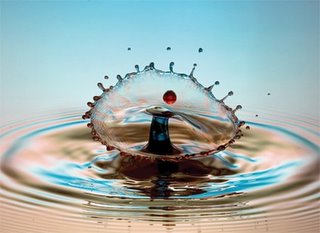Back to The Path
I've been severely digressing from my chosen path of late. But Tipping Point woke me up and made me realise that my passion still lies in children's education. The book is about "small things that make a big difference". Part of the book is about the making of Sesame Street. It's been a revelation. It's all about how children learn and what filmmakers did to find out this process and respond to it. Blue's Clues achieved and even higher success rate of teaching children by paying very close attention to their viewing patterns etc and developing a technique to improve "stickiness" (meaning information that is remembered or 'sticks in the mind'.
I've done my dissertation on Production Design in Cinema, spent three months researching Autism to which the only solution is education. Connect them, perhaps by designing a TV Show Pilot that educates about disability. - Must think about this one! It sounds good except for two huge hurdles. Both came from a particular tutor during my last design brief presentation whose name shall remain unspoken. He has been overtly critical towards everything I've ever done...and not in a positive way....'cause there is a difference) Anyway, apparently I'd have to find a consulting psychologist and the ethics committee at Goldsmiths that apparently has to evaluate projects like these. (For goodness' sake it's a theoretical design project, not a live one that goes into production tomorrow...grumble...burocratism has hindered so many worthy projects. Since the dawn of time there's always been The 'BUT' people whose narrow mind, lack of imagination and negative attitude stopped free thinkers to get on with it!)
Bullying is a major problem and often it is due to lack of education about empathy, understanding and tolerance. Growing up in Hungary, I've not experienced this, neither my Polish friends. What is it that Eastern European schools teach or perhaps how? that discourages such behaviour. What is it in British culture or education that seems to encourage it? There must be a major difference somewhere. No doubt, it's partly a sociological problem to which many very clever people are trying to find answers right now. - Lack of Empathy is the prevalent sign of Autism. Which brings me back to my original thought process and project direction, the "Autistic Society'.
Why did I digress from this? Because it's too difficult, because I got stuck and true to my style I allowed myself to divert to something more immediately satisfying. When my mentor mentioned Biomimicry, I fell in love with the idea and abandoned 'ship'. But it seems I jumped too early, as it's not sinking just yet. I have to write a 5000 words project brief, which might give me some clarity and design ideas. Biomimicry as fascinating it is, will have to wait, until this designer 'sailed the first ship into port'.
I've done my dissertation on Production Design in Cinema, spent three months researching Autism to which the only solution is education. Connect them, perhaps by designing a TV Show Pilot that educates about disability. - Must think about this one! It sounds good except for two huge hurdles. Both came from a particular tutor during my last design brief presentation whose name shall remain unspoken. He has been overtly critical towards everything I've ever done...and not in a positive way....'cause there is a difference) Anyway, apparently I'd have to find a consulting psychologist and the ethics committee at Goldsmiths that apparently has to evaluate projects like these. (For goodness' sake it's a theoretical design project, not a live one that goes into production tomorrow...grumble...burocratism has hindered so many worthy projects. Since the dawn of time there's always been The 'BUT' people whose narrow mind, lack of imagination and negative attitude stopped free thinkers to get on with it!)
Bullying is a major problem and often it is due to lack of education about empathy, understanding and tolerance. Growing up in Hungary, I've not experienced this, neither my Polish friends. What is it that Eastern European schools teach or perhaps how? that discourages such behaviour. What is it in British culture or education that seems to encourage it? There must be a major difference somewhere. No doubt, it's partly a sociological problem to which many very clever people are trying to find answers right now. - Lack of Empathy is the prevalent sign of Autism. Which brings me back to my original thought process and project direction, the "Autistic Society'.
Why did I digress from this? Because it's too difficult, because I got stuck and true to my style I allowed myself to divert to something more immediately satisfying. When my mentor mentioned Biomimicry, I fell in love with the idea and abandoned 'ship'. But it seems I jumped too early, as it's not sinking just yet. I have to write a 5000 words project brief, which might give me some clarity and design ideas. Biomimicry as fascinating it is, will have to wait, until this designer 'sailed the first ship into port'.










